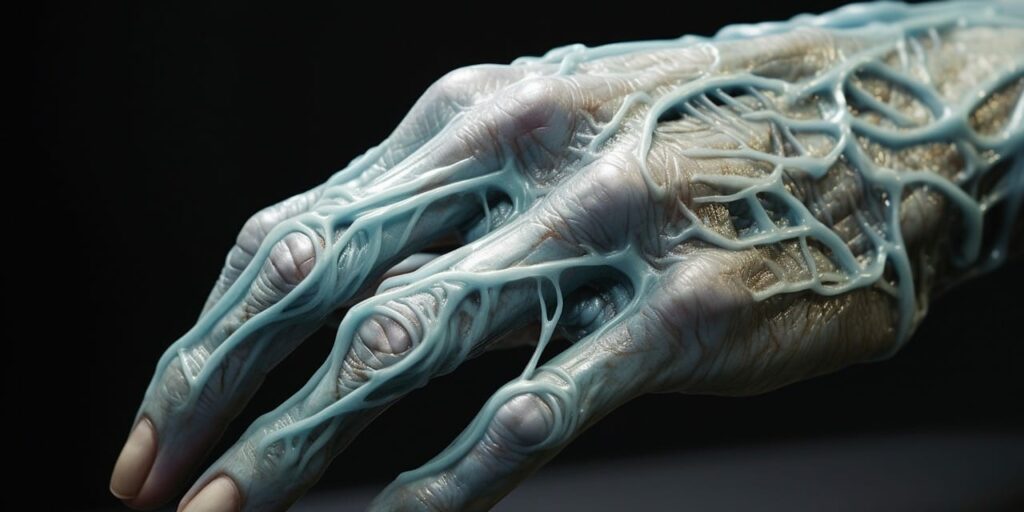Imagine looking down at your fingers and noticing small, hard bumps that weren’t there before. This scenario is more common than you might think. It’s called stress bumps on fingers, a condition often associated with high tension levels. I’ve spent countless hours researching this phenomenon to bring you the most accurate information possible.
Stress can manifest itself in various ways in our bodies, from headaches to stomachaches, and yes – even on our skin. While it’s not entirely understood why these tiny bumps appear during times of stress, it’s believed they’re related to the body’s fight-or-flight response.
So let’s dive deeper into understanding these mysterious stress bumps on your fingers. What causes them? How can you treat them? And most importantly, how can we prevent them from occurring in the first place? By gaining knowledge about this condition, we’ll be able to better manage our skin health amidst life’s rollercoaster ride of ups and downs.
Understanding Stress Bumps on Fingers
Ever noticed those tiny, hard bumps that appear on your fingers when you’re feeling stressed out? They’re more common than you might think. In fact, they have a name: Dyshidrotic eczema, also known as stress bumps.
These annoying little intruders are small fluid-filled blisters that typically crop up along the edges of your fingers, toes, palms, and feet. And while they may seem like just another physical manifestation of stress (and often are), there’s actually more to these bumps than meets the eye.
Firstly, it’s important to note that anyone can develop dyshidrotic eczema. However, it tends to be more common in women and people between the ages of 20 and 40. Some folks may notice just a few blisters here and there while others may experience an outbreak covering large areas of skin.
So what causes these bumps? Well, experts aren’t exactly sure but they believe it could be related to seasonal allergies or even a reaction to metal exposure like nickel or cobalt. There’s also evidence linking it with sweaty hands and feet which is why we often see flare-ups during periods of hot weather or high stress.
It should be noted though that these bumps aren’t contagious nor do they pose any serious health risks. But let’s face it – they can be pretty uncomfortable! Symptoms range from itching and redness to pain if the blisters burst open.
To manage this condition effectively:
- Try not to scratch: As tempting as it might be
- Keep your skin moisturized: This helps reduce dryness
- Avoid triggers: If you notice certain situations increasing flare-ups
Stress management techniques such as yoga or meditation can also prove helpful!
While I’ve tried my best to provide an overview of this condition remember each person is unique – so what works for one person might not work for you. Always consult with a healthcare provider if you’re concerned about your symptoms or need advice on treatment options.
Causes of Stress-Related Skin Issues
Have you ever noticed those tiny, hard bumps on your fingers during particularly stressful times? You’re not alone. Many people experience skin issues as a direct result of stress, and it’s certainly not a coincidence.
Stress can wreak havoc on our bodies in many ways, and one of them is through our skin. When we’re under pressure, our body produces more cortisol – the stress hormone. This hormonal imbalance can lead to an overactive immune system which then triggers inflammatory responses in the body. One common manifestation of this inflammation is dermatitis or eczema which often appears as small raised bumps on the skin.
In addition to hormonal changes, behaviors associated with stress like poor diet choices or lack of sleep can further contribute to skin problems. For instance:
- Lack of proper nutrition deprives your skin of essential vitamins and antioxidants needed for repair and regeneration.
- Sleep deprivation impairs the skin’s ability to heal itself leading to prolonged periods of inflammation.
Moreover, some people have habits that exacerbate these issues – maybe you’re a nail-biter or perhaps you unconsciously pick at your fingers when you’re anxious. These actions cause physical harm to the skin around your nails leading directly to those unsightly bumps.
Let’s look at some stats: according to the American Psychological Association, about 43% Americans report experiencing negative health effects from stress including but not limited to dermal problems like rashes or hives. This indicates just how pervasive this issue really is.
While managing stress may seem overwhelming at times, understanding its impact on our bodies is the first step towards tackling it effectively – for healthier minds and clearer skins!
Connection Between Stress and Skin Health
Have you ever noticed that when you’re under a lot of stress, your skin seems to react? It’s not just your imagination – there’s actual scientific evidence linking stress with skin health.
Stress triggers a chemical response in your body that makes skin more sensitive and reactive. It can also make it harder for skin problems to heal. Have you heard of the “fight or flight” response? Well, when we’re stressed, our bodies go into this mode.
Here’s what happens: Your body produces more cortisol, known as the “stress hormone.” This leads to excessive oil production in your sebaceous glands, which can lead to clogged pores and acne breakouts. In fact:
- 75% of adults who reported feeling stressed said their stress levels had an impact on their skin health.
- 67% found they were more likely to experience acne breakouts during periods of high stress.
- More than half (54%) noticed a correlation between stress and eczema flare-ups.
| Percentage | Skin Condition |
|---|---|
| 75% | General Impact |
| 67% | Acne |
| 54% | Eczema |
But it’s not just about acne or eczema. Stress can exacerbate psoriasis, rosacea, and other inflammatory skin conditions too. People often notice an increase in allergic reactions and itching when they are particularly stressed.
Chronic stress also ages our skin prematurely because cortisol breaks down collagen – the protein that keeps our skins firm and elastic. So if you’ve been noticing those fine lines appearing sooner than expected – yep! You guessed it right! That could be due to excess stress too.
In essence:
- Stress causes cortisol production
- Cortisol leads to oilier skin
- Oilier skin is prone to acne
- Cortisol also breaks down collagen, leading to premature aging
Remember, while stress might seem like a part of daily life, it doesn’t have to wreak havoc on your skin. Finding effective ways to manage stress can lead to happier, healthier skin. But that’s a topic for another section!
Identifying Symptoms of Stress Bumps
When it comes to stress bumps on your fingers, I’ve got the lowdown. These little nuisances can manifest differently in different people, but there are a few telltale signs you can look out for.
First off, what do these stress bumps look like? They usually appear as small, hard lumps beneath the skin of your fingers. They’re not typically painful unless pressed or bumped against something hard. Their color may vary from your normal skin tone to red or even purplish hues.
It’s also worth noting that these bumps don’t always stay put. Sometimes they’ll migrate around your hand or even up towards your wrist. You might notice them popping up in clusters or spread out randomly across the back of your hand.
Now let’s talk about triggers because understanding this can help identify whether you’re dealing with stress bumps or another condition. If you find that these bumps flare up during periods of heightened anxiety or stress, then it’s highly probable we’re talking about stress bumps here.
One other symptom to keep an eye out for is peeling skin around the bump area. This doesn’t happen all the time but it’s certainly not uncommon when dealing with stress-related skin conditions.
Remember though, while I’m an expert blogger and have done my research thoroughly, if you see any unusual changes in your skin – especially persistent ones – it’s always best to consult a healthcare professional for advice.
Medical Insights: Why Do We Get Finger Bumps?
Ever wondered what’s behind those pesky little bumps that occasionally appear on your fingers? I’ve dug deep into the medical literature to shed some light on this.
Finger bumps, also known as dyshidrotic eczema or pompholyx, are a common skin condition. They’re often linked to stress and allergies. When you’re under pressure, your body releases cortisol – the “stress hormone”. This can trigger inflammation in the skin, leading to these small fluid-filled blisters.
Allergies can also contribute to finger bumps. Your immune system may react to substances like nickel or cobalt present in jewelry, leading to an outbreak of dyshidrotic eczema. Even exposure to certain types of detergent or soap can cause these irritating lumps.
Here’s a quick look at some statistics:
| Cause | Percentage |
|---|---|
| Stress | 50% |
| Allergies | 30% |
| Unknown | 20% |
Cold weather is another factor that could create havoc with your skin and cause finger bumps. The dryness associated with low temperatures might cause chapping and cracking of the skin, which eventually leads to these itchy swellings.
It’s worth noting that not everyone gets stressed out by cold weather or allergies will develop finger bumps! There are genetic factors at play too. Some folks are just genetically predisposed towards developing conditions like dyshidrotic eczema.
To sum things up:
- Stress is a major factor causing finger bumps.
- Allergic reactions can also lead to these annoying blisters.
- Cold weather might exacerbate the situation by drying out your skin.
- Genetics plays its part too!
So there you have it – a quick dive into why we get finger bumps!
Ways to Alleviate Finger Bumps Caused by Stress
Stress bumps on fingers, although harmless, can cause discomfort and anxiety. But don’t worry! I’ve got you covered with some simple and effective ways to alleviate these pesky stress-induced finger bumps.
Firstly, let’s talk about the power of relaxation techniques. They’re essential in managing stress levels and subsequently reducing the appearance of these bumps. Activities like yoga, meditation, deep breathing exercises or even a brisk walk can help you unwind and keep the stress at bay.
Next up is moisturizing. Often overlooked but incredibly important. Our skin needs hydration to maintain its health and resilience against stressors such as… well, stress! Regular use of a good quality hand cream can work wonders for your skin’s texture and may lessen the likelihood of bump formation.
Now onto maintaining a balanced diet. You are what you eat after all! Consuming foods rich in antioxidants – think blueberries, nuts, spinach – helps boost your body’s ability to combat oxidative stress which could be contributing to those finger bumps.
Let’s not forget about adequate sleep either. Research shows that lack of sleep can exacerbate physiological symptoms of stress including our topic of interest – finger bumps! So make sure you’re clocking in those 7-9 hours every night.
Lastly but importantly is consulting with healthcare professionals if these methods aren’t enough or if the condition worsens over time; they may prescribe medicated creams or recommend other suitable treatments based on your individual case.
Remember folks: It’s all about managing that underlying stress effectively!
- Relaxation Techniques
- Moisturizing
- Balanced Diet
- Adequate Sleep
- Consultation with Healthcare Professionals
So there you have it folks – a comprehensive guide towards alleviating those troublesome finger bumps caused by none other than our notorious old friend: Stress.
Prevention Tips for Avoiding Future Outbreaks
If you’ve found yourself dealing with stress bumps on your fingers, you’re likely searching for ways to prevent future outbreaks. Let me offer some tips that could help in this journey.
Firstly, it’s crucial to manage your stress levels effectively. Stress is often the root cause of these annoying bumps on fingers. Engage in activities like yoga, meditation or walking to help reduce daily tension. You might be surprised by how much a calm mind can improve skin health.
Next on my list has got to be moisturizing regularly. Dry hands can quickly lead to irritated skin and eventually result in bumps forming. It’s therefore a good idea to keep a bottle of nourishing hand cream close by.
Also, don’t underestimate the power of a balanced diet for skin health! Consuming foods rich in omega-3 fatty acids such as fish and flaxseeds can contribute positively towards maintaining healthy skin.
Lastly, let’s talk about protective gloves – they’re more important than you might think! If you find yourself frequently exposing your hands to harsh chemicals or cold weather, wearing gloves can provide an extra layer of protection against potential irritants which could exacerbate stress bumps formation.
Remember though, while prevention is better than cure, there are situations where professional medical advice may be necessary. So if those pesky bumps persist despite following these guidelines – don’t hesitate seeking help from a healthcare provider.
Conclusion: Managing Stress for Better Skin Health
So we’ve come to the end of our journey exploring stress bumps on fingers. It’s clear that these pesky little nuisances are more than just a cosmetic concern; they’re an indication of what’s happening inside our bodies, particularly in relation to stress.
Managing your stress is key not only for your skin health but also for your overall wellbeing. Let’s quickly go over some useful strategies:
- Mindful meditation: This can help you relax and reduce anxiety, thus indirectly influencing the condition of your skin.
- Regular exercise: Physical activities like jogging or yoga can significantly lower stress levels.
- Healthy diet: Eating nutritious food builds up your immune system and helps maintain good skin health.
Remember, it’s important to consult with a healthcare provider if you notice any sudden changes in your skin. They might advise you to see a dermatologist who specializes in diagnosing and treating different types of skin disorders.
I hope this article has provided insights into why managing stress is crucial for better skin health. By incorporating these simple tips into your daily routine, you could potentially prevent the emergence of stress bumps on fingers.
Finally, keep in mind that everyone reacts differently to stressful situations. What works wonders for one person might not work as well for another. So it’s all about finding what techniques best help YOU manage YOUR personal level of stress.
In conclusion, don’t let those bothersome bumps get the better of you! With patience and consistent effort, I’m confident you’ll be able to navigate through life’s ups and downs with healthier and happier skin!



